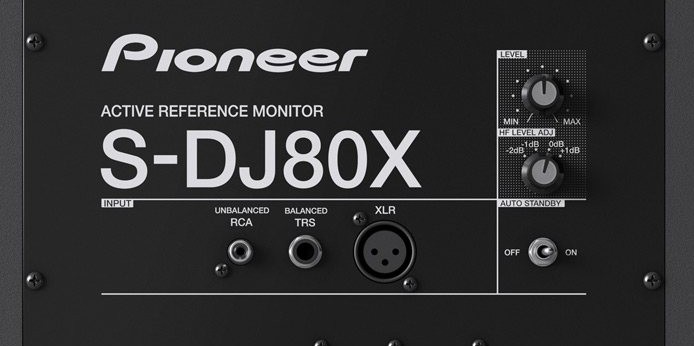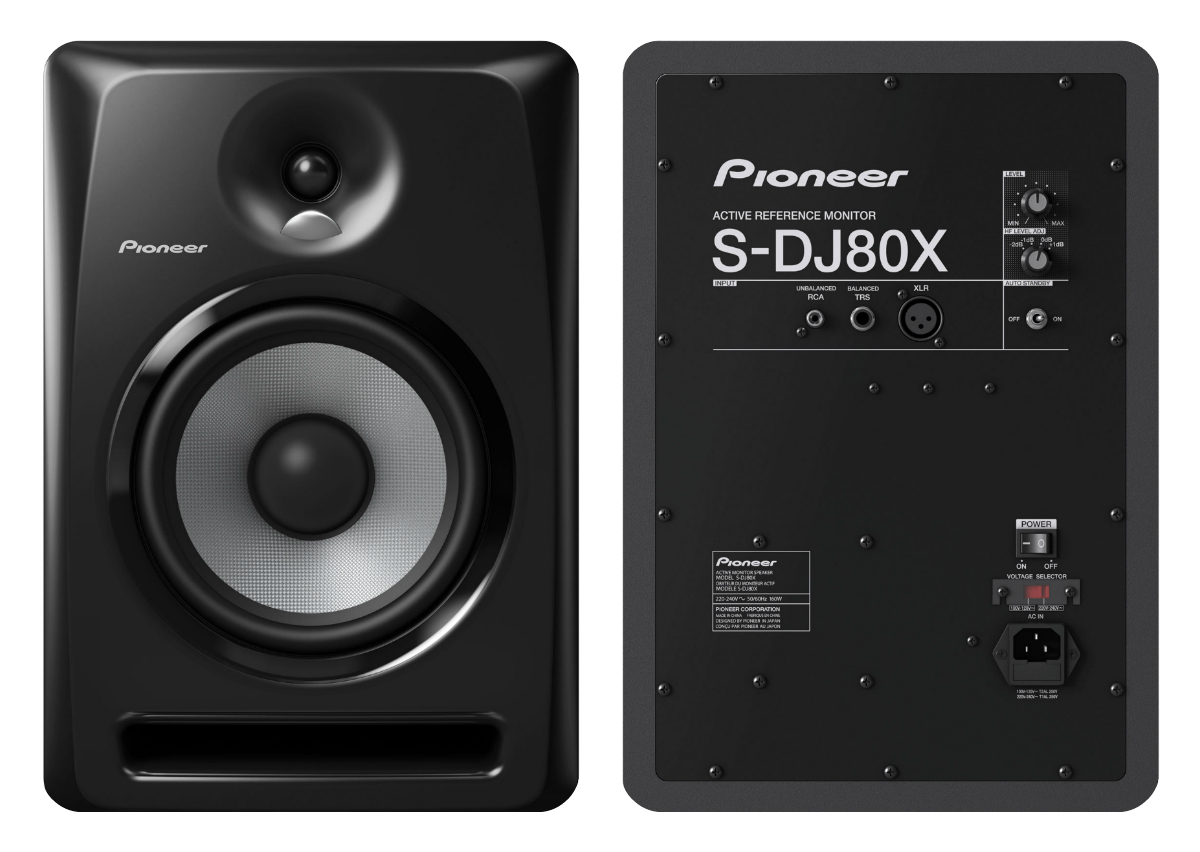The Lowdown
The Pioneer S-DJ80X’s are the biggest speakers in a high-quality powered monitor range designed and built for dance DJ/producers. They’re imposing, sleek and powerful with high-grade components and rock-solid build quality delivering a punchy performance that never waivers even at high volumes. Just don’t buy too big for your room if you want a hope of taming that bass!
Video Review
First Impressions / Setting up
The speakers are robust and expensive looking, with a sleek and uncomplicated front-panel design giving an air of recording studio quality and professionalism with no hint of “style over substance” or gimmicky design features or colour splashes. The silver-grey textured “aramid fibre” woofers look great and the power indicator is a perfectly subtle crescent-shaped glow just under the tweeters; other than these and the Pioneer logo there’s nothing more on the shiny all-black facia. Underneath there’s a well-needed slimline foam-rubber “foot” to eliminate rattle on desktop surfaces and aid with dampening.
It’s a similarly understated story round the back, with minimal knobs and buttons to play with (perhaps too few for our liking, more on this later). Each unit is powered and has its own power supply and amplifier, hence the presence of the jumbo AC input socket.

There’s a power switch and an on/off toggle switch for the extremely useful auto standby feature, which powers down the units after 25 minutes of inactivity, saving you having to fish round the back to find the power switch every time. When it awakens from its slumber, it’s a controlled process ensuring that there’s no loud crack firing out of the speakers when powering up a USB audio interface, for example. There’s no cooling fin on the back though; hopefully overheating doesn’t become an issue.
In terms of inputs there’s plenty of versatility here, with the three options of XLR, balanced TRS and unbalanced RCA ensuring you should have no trouble hooking up your most utilised audio sources; you could for example have your DJ controller permanently plugged into one input, with two inputs to spare for any other sources, such as your TV or computer. Bear in mind that these input sources cannot be isolated or switched between, meaning that any signal coming from different sources will be “mixed” and outputted through the speaker simultaneously.
(Note: they have a single XLR, a single RCA and a single jack on each unit because they are powered individually, so you’ll need to connect one side of your stereo signal into each.)
There are two more controls on the rear panel: the main volume control level and a high frequency adjustment knob giving you the option to cut the top-end by 1 or 2db, or boost it by 1db. However the omission of the same control over the low frequencies is a puzzling decision (along with the lack of a remote control) that disadvantages these speakers against some competitors and caused frustrations is testing.
In addition to the DJ environments these are designed for, Pioneer’s marketing video shows young hipsters carting these round and rocking 100-strong open air parties with these speakers alone, giving the impression that these would be suitable PA speakers, which is to our mind highly inadvisable.
Despite not being designed to be transportable at all, with slippery sides and no handles (it was difficult enough getting them out of their box let alone lugging down to the beach for an impromptu rave!), even the best studio monitors are vulnerable to physical damage and being blown through abuse in highly demanding public situations. We think these are best positioned, tweaked to suit the room, and used daily to DJ from a fixed position.
In Use
We tested the S-DJ80Xs, which are the largest of the three in the range. Like all their stablemates, they are well-built, chunky and reassuringly heavy. In this case, the overall presence of the 80’s (as the big daddies of the range) was a tad over-imposing in our medium-sized room, mainly due to the depth of the cabinets and the extra room needed to accommodate the power supply coming from the rear pushing them quite far into the space. Having said that, with the 60X and 50X versions (reviews coming) there are options to suit smaller rooms.

When testing the S-DJ80Xs, I performed a direct swap out of my normal set up of Yamaha HS50M’s with an essential but old (and lovely sounding) JBL subwoofer, and my first thought was “whoa! I don’t need that subwoofer connected any more”! Admittedly this is not a like-for-like comparison, the Pioneers having the eight-inch driver to the Yamahas’ five-inch, but immediately I could tell we were listening to a speaker designed to hammer out dance music with plenty of kick rather than hear a flat signal. The Pioneers are not sold as flat-response studio monitors, and when compared directly to the Yamahas you can hear why.
I chose a few of my most bassy deep house killers and settled in for the test, and overall the music reproduction was excellent. Most notably the bass – deep, punchy and taut, with a lot of definition. The highs are crisp and clear with no harshness even at high volumes and overall these speakers initially sounded well rounded and impressive with many an office “hand in the air moment” created when testing tracks individually.
To most dance music DJs on paper this may sound great, but just a word of caution: When using the speakers in mixing (recording a mix actually) this initially impressive low-end grunt became at times a woolly and overbearing bass vortex, making it tricky to define the distinct crisp frequencies required to keep the mix locked in, especially at lower volumes (the Pioneer’s seem to come alive when driven anywhere over around 60% of their capability, not unlike a Ferrari’s engine does over 6000 rpm, ahem, apparently).
This rumble was undoubtedly a product of the combination of the speaker size, power and position being in conflict with the room dynamics, plus the front-port bass design; so without a method of controlling the low frequencies my only option to tame the thunder was to adjust the EQ at the mixer; not an option when recording! It turns out then that the impressive bass, is not, as far as my ears could tell, a true flat representation of the source material. Of course this is by no means a definitive judgement; your mileage may vary.
If I was having a house party, the crowd would love it, but as the DJ I may be resorting to monitoring in the headphones to stay on point with mixes. Listen yourself, though: It’s an inconvenience that is arguably more than made up for in the pure dancefloor-destroying power of these beefy speakers.
Conclusion
For pure party-rocking power these speakers are fantastic. They are solidly built, versatile and will look the part in any DJs set up. In comparison with the price and performance of the KRK and Reloop options there’s evidence of a nominal price tag purely for the Pioneer logo, but because these are aimed squarely at the prosumer or pro DJs who are probably already fierce Pioneer stalwarts it’s not unexpected.
Be cautious if you have limited space or are expecting to hear a flat-response interpretation of your output; our recommendation would be to choose the model that fits your room and not super-size your order unless you are 100% sure your room needs it, because even at low volumes the S-DJ80Xs have dog-frightening levels of low-end presence which only seems to be in proportion when they are driven loud, by which time the dog is long-gone, as are the neighbours. Of course you could argue that dance music is all about the thump, and these speakers deliver on Pioneer’s promise of “rich bass and a tight, punchy kick even at high volumes without resonance”.




